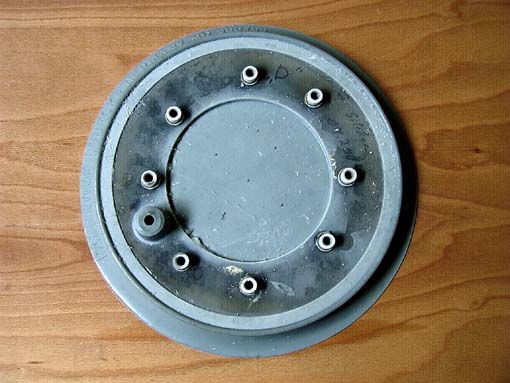

Carrying Capacity of Suction Cups
388 and 388-SI
An investigation by the Fachhochschule Kiel
(executed in the first half year 2004)
conducted by Professor Dr.-Ing. Michael Klausner
Experiment set-up
At room temperature
Picture 1: The suction cups are placed on a clean glass plate (1) and connected to 0.6 bar partial vacuum. A Venturi jet with noise insulation coat (2) as well as a vacuum tank (3) provides the vacuum system.
On the suction cup is exerted via the weight loaded lever (6) a statical force via the load cell (4) (type: HBM U2B 10 kN) (6), which is taken over at the measuring bridge (8) (type: HBM MGC55-AB1).
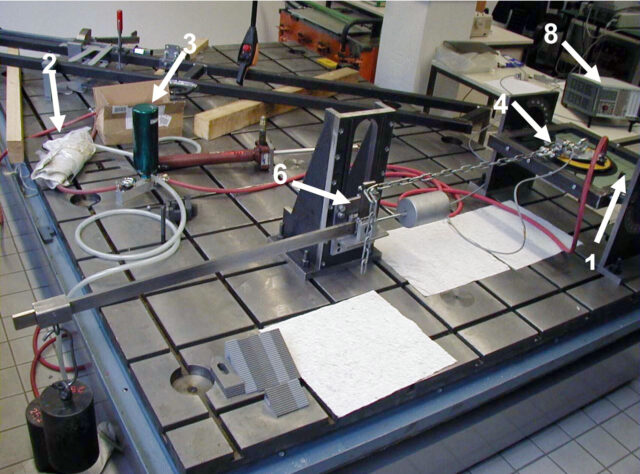
At low temperature
The suction cups are put on a clean glass plate and connected to 0.6 bar partial vacuum, there is a Venturi jet with vacuum tank as partial vacuum supply. The entire test arrangement is shown on picture 1. The suction cups are weighted dynamically via a hydraulic cylinder, the tie force is acquired by a force-sensing device and registered by a measuring bridge. Read-off is the maximum value of the force. For the tension tests vertical to the glass the tension direction was arranged inclined in the deep freezer, the arising error of measurement from this remains smaller than 0.3%.

At the measurements tensile direction parallel to the glass, the arrangement could be placed vertically. The tensile direction parallel to the glass is the type of burden during a vertical transport of the glass.
Trials at room temperature
Suction cup 388 with mark 080404 – 2
(new rubber mixture, which is in use since May 2004)
The suction cup was loaded statically to measure slipping at room temperature.
Force Behaviour
2400 N suction cup holds
2612 N suction cup holds after approx. 2.5 mm creeping phase of 3 min duration
2688 N suction cup slips constantly at 4 mm / min
Suction cup 388 with mark 080404 – 3
(new rubber mixture, which is in use since May 2004)
The suction cup was loaded statically to measure slipping at room temperature.
Force Behaviour
2461 N suction cup holds
2851 N suction cup holds after 4 mm creeping phase of 2 min duration
3123 N suction cup holds after 9 mm creeping phase of 7 min duration
3297 N suction cup slips constantly at 8 mm / 2 min
Suction cup 388-SI with mark 004/2004 C
(silicon, light grey, marked with felt-tip pen: 04/2004 „C“)
The suction cup was loaded statically to measure slipping at room temperature.
- Series of measurements
Force Behaviour
1650 N suction cup holds
1721 N suction cup slips constantly at 2 mm / 3 min
1751 N suction cup slips constantly at 8 mm / 3 min
- Series of measurements
Force Behaviour
1708 N suction cup holds
1789 N suction cup holds after 5 mm creeping phase of 3 min duration
1810 N suction cup slips constantly at 10 mm / 3 min
Suction cup 388-SI with mark 004/2004 D
(silicon, light grey, marked with felt-tip pen: 04/2004 „D“)
The suction cup was loaded statically to measure slipping at room temperature.
Force Behaviour
2120 N suction cup holds
2286 N suction cup slips off immediately
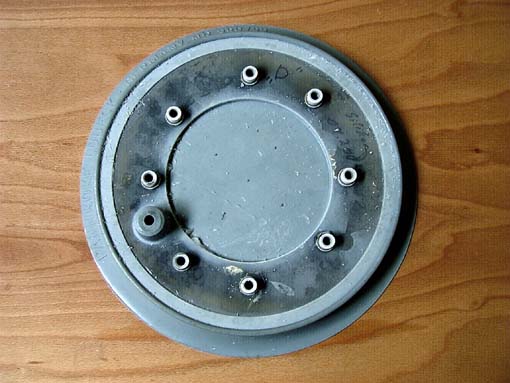
Low temperature trials
- Series of measurements, -20.2 °C
Suction cup 388 with mark 080404 – 2 and 080404 – 3
(new rubber mixture, which is in use since May 2004)
suction cups are hard and can’t be brought to suction even by pressing on.
Suction cup 388-SI with mark 004/2004 C
(silicon, light grey, marked with felt-tip pen: 04/2004 „C“)
Force Behaviour
1487 N suction cup holds
1972 N suction cup slips constantly at 0.5 mm / 3 min
Suction cup 388-SI with mark 004/2004 D
(silicon, light grey, marked with felt-tip pen: 04/2004 „D“)
Force Behaviour
1752 N suction cup holds
2000 N suction cup slips constantly at 0.5 mm / 7 min
2532 N suction cup slips constantly at 0.5 mm / 2 min
2617 N suction cup slips constantly at 0.5 mm / 0.5 min
- Series of measurements, -33.6 °C
Suction cup 388 with mark 080404 – 2 and 080404 – 3
(new rubber mixture, which is in use since May 2004)
Suction cup hard, doesn’t suction even after pressing on.
Suction cup 388-SI with mark 004/2004 C
(silicon, light grey, marked with felt-tip pen: 04/2004 „C“)
Force Behaviour
1800 N suction cup holds
2100 N suction cup holds
2300 N suction cup slips constantly at 0.5 mm / 10 min
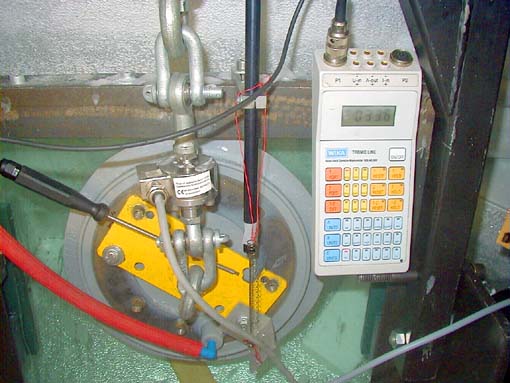
Suction cup 388-SI with mark 004/2004 D
(silicon, light grey, marked with felt-tip pen: 04/2004 „D“)
Force Behaviour
2500 N suction cup slips under 0.5 mm / 10 min, holds at renewed setting
3000 N suction cup slips constantly at 1 mm / 6 min
3500 N suction cup slips constantly at 1.5 mm / 1 min
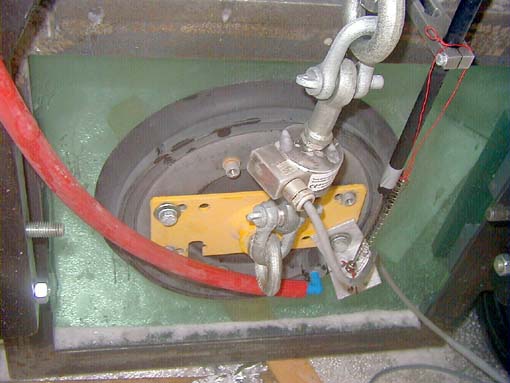
Results
The suction cups made of the new rubber mixture hold at room temperature till 2400 N without slipping. Moreover the suction cup 080404 – 3 comes after a creeping phase even at approximately 3000 N to a standstill.
This value corresponds well with the result of the first tests for the suction cup 388 with the new rubber mixture (2300 N) from the report of 04 May 2004.
At low temperatures the new rubber quality is not useable at approximately –20°C.
The silicon suction cups are less capable of bearing at room temperature. Exemplar „C“ held till 1700 N, but „D“ could be loaded till 2100 N. Noticeable was a strong retraction of the outer lip under the plate. This may be caused by the low hardness but otherwise has no influence.
The silicon suction cups show till approximately –20°C no noticeable hardening. This corresponds to the fastness similar to that at room temperature. At approximately –30°C the suction cups are going to be a little firmer, the summoning forces increase noticeably.
Finally the good behaviour of the new rubber mixture is confirmed. For low temperatures the silicon types are suitable.
Kiel, 8.6.2004
Prof. Dr.-Ing. Michael Klausner
